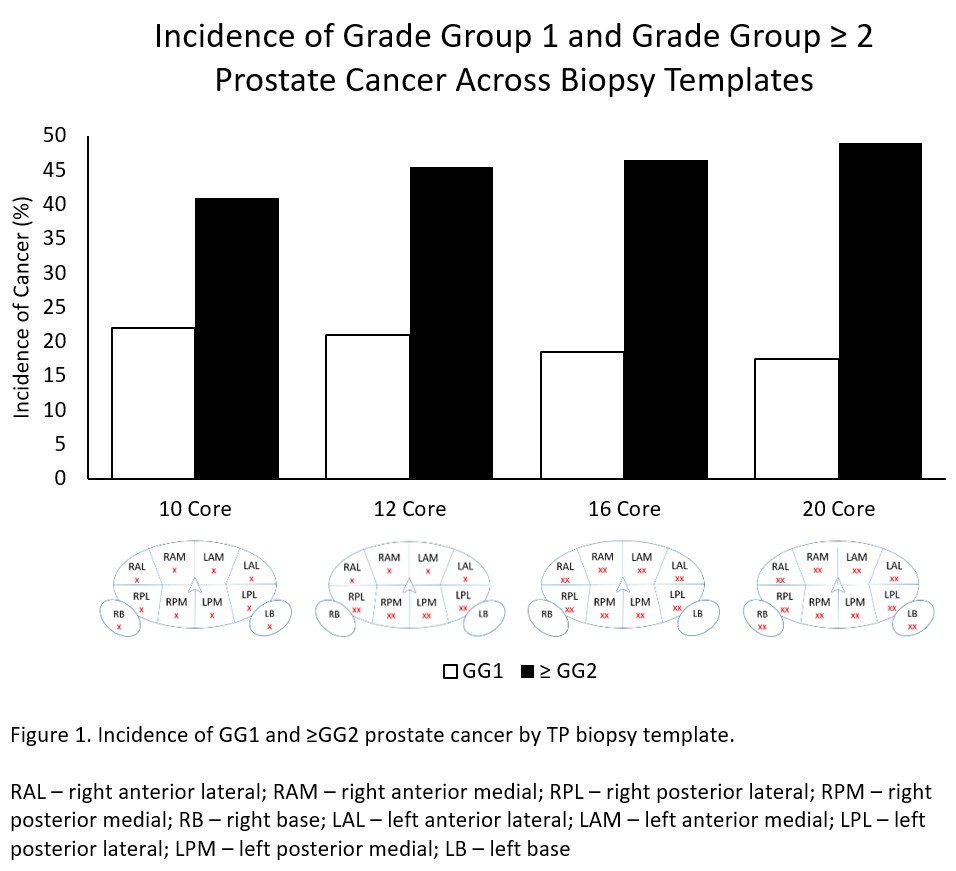How many cores are enough? Optimizing the systematic transperineal prostate biopsy template
Christian Schaufler, BS, Ryan Daigle, BS, Summit Singhaviranon, BS, Carl K. Gjertson, MD, Peter C. Albertsen, MD, Benjamin T. Ristau, MD.
UConn Health, Farmington, CT, USA.
BACKGROUND: Most urologists use a 10-12 core systematic transrectal (TR) prostate biopsy template. However, a similar consensus template has not been reached for transperineal prostate biopsy (TP) regarding the optimal number and location of biopsy cores. We examined our institutional cohort to define an optimal systematic template for TP.
METHODS: We prospectively monitored our first 200 consecutive free-hand TP biopsies. Men who were biopsy na´ve (BN, n=117), had elevated PSA with prior negative biopsy (PNB, n=18), and men on active surveillance (AS=65) were included. All underwent 20 core TP biopsy with each core placed in a separate specimen container. 10, 12, and 16 core templates were designed a priori and compared within each patient to the 20-core standard (Figure 1). The primary outcome was detection of Grade Group ≥ 2 (GG2) relative to detection of Grade Group 1 (GG1) prostate cancer. An historic cohort of 12 core TR biopsy (n=170) was used to compare prostate cancer detection between techniques. Sub-group analyses of BN men and men stratified by PSA density (<0.15 vs ≥0.15ng/cc/mL) were performed.
RESULTS:≥GG2 cancers were detected in 98 (49%, 20 core), 93 (47%, 16 core), 91 (46%, 12 core), and 82 (41%, 10 core, p=0.13) men. More ≥GG2 were detected in the 20 core compared to the 10 core template (49% v. 41%, p = 0.02). Additional cores did not result in increased GG1 detection (20 core: 35 vs. 10 core: 44, p = 0.09) reflecting improved detection of concomitant ≥GG2 with more cores sampled. There was no significant difference in ≥GG2 detection between an historic 12 core BN TR series (n=148) and the 12 core BN TP cohort (38% vs. 44.5%, p = 0.11). Among BN men, detection of ≥GG2 was similar to the overall cohort: 56 (48%, 20 core), 53 (46%, 16 core), 52 (45%, 12 core), and 47 (41%, 10 core, p=0.14). In men with a PSA density of <0.15ng/cc/mL, ≥GG2 was found in ≤ 25% of samples across all templates. CONCLUSIONS: A 20 core TP systematic biopsy template demonstrated improved detection of ≥GG2 prostate cancer compared to a 10 core TP template. Increasing core number did not result in greater detection of GG1 tumors. Systematic templates with fewer cores may be feasible in patients with PSA density < 0.15 ng/ml/cc. We propose a 20 core systematic TP biopsy template against which future work including MRI-targeted TP biopsies can be compared. 
Back to 2021 Abstracts
